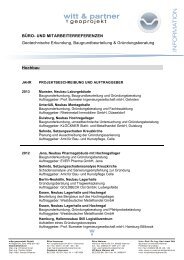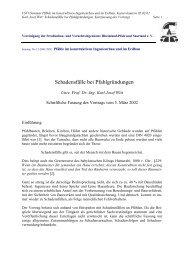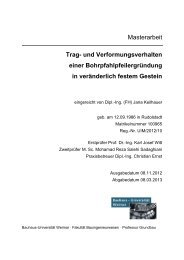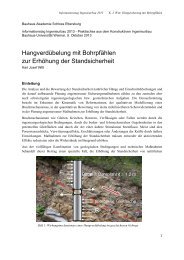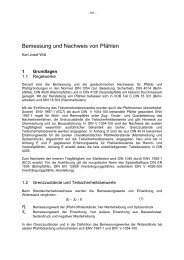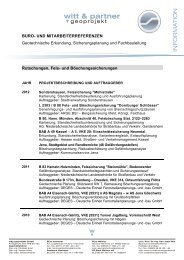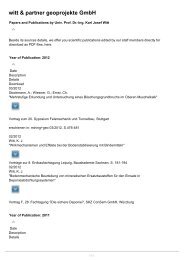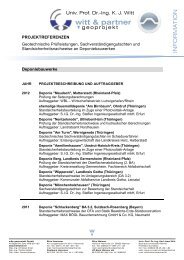A Static Analysis of Hydraulic Heave in Cohesive Soil - witt & partner ...
A Static Analysis of Hydraulic Heave in Cohesive Soil - witt & partner ...
A Static Analysis of Hydraulic Heave in Cohesive Soil - witt & partner ...
Create successful ePaper yourself
Turn your PDF publications into a flip-book with our unique Google optimized e-Paper software.
At the base <strong>of</strong> a wall the hydraulic gradient on a<br />
support<strong>in</strong>g sheet pile wall <strong>of</strong> an excavation reaches the<br />
highest values. The realisable potential difference at the<br />
base <strong>of</strong> the wall ∆h u is the excess head related to the<br />
deepest part <strong>of</strong> the sheet pile wall and can be estimated<br />
with formula 6:<br />
∆h<br />
u<br />
cu<br />
t ⋅ γ'<br />
+ 15 ,<br />
=<br />
m<br />
(6)<br />
γ<br />
w<br />
γ’ = submerged unit weight and γ w = unit weight <strong>of</strong><br />
water.<br />
III. ANALYSIS OF STRESS STATE<br />
In eng<strong>in</strong>eer<strong>in</strong>g practice there are two typical situations<br />
known for failure due to hydraulic heave, the downstream<br />
foot <strong>of</strong> a relative impervious dam or a weir above a<br />
pervious soil and an excavation with a impervious support<br />
(sheet pile). Referr<strong>in</strong>g to both seepage forces oppose the<br />
forces <strong>of</strong> gravity, neutraliz<strong>in</strong>g a part or the whole weight<br />
<strong>of</strong> the soil. Thus the effective stress and the shear strength<br />
decrease. To analyse the changes <strong>of</strong> stress and the<br />
deformation <strong>in</strong> a cohesive soil the <strong>in</strong>flow <strong>of</strong> an excavation<br />
was simulated by us<strong>in</strong>g the program PLAXIS and a briefly<br />
calculation <strong>of</strong> hydraulic pressures by PLAXFLOW. The<br />
geological circumstances are characterised by a cohesive<br />
soil located under a 10 m thick layer <strong>of</strong> non cohesive<br />
material.<br />
Referr<strong>in</strong>g to Fig. 6 the cross section <strong>of</strong> the system is<br />
characterised by gravel with its typical shear parameters,<br />
deformation behaviour and permeability. Under this<br />
relative permeable sediment there is a dense layer <strong>of</strong> silty<br />
and clayey sand. This soil shows typical low cohesive<br />
behaviour. The permeability <strong>of</strong> the gravel is more than<br />
100 times higher than those <strong>of</strong> the cohesive material. In<br />
general there is no activation <strong>of</strong> flow forces with<strong>in</strong> the<br />
gravel <strong>in</strong> comparison to the silt. For reasons <strong>of</strong> calculation<br />
there is no difference taken <strong>in</strong>to account between<br />
horizontal and vertical permeability with<strong>in</strong> both layers.<br />
In the first step the excavation and the <strong>in</strong>stallation <strong>of</strong> the<br />
support<strong>in</strong>g elements, thus the sheet pile wall and anchors,<br />
were <strong>in</strong>serted. Before rais<strong>in</strong>g the water level, it was<br />
def<strong>in</strong>ed at a depth similar to the bottom <strong>of</strong> the excavation.<br />
Fig. 6 illustrates an overview <strong>of</strong> the geological and<br />
hydrological conditions used with<strong>in</strong> the calculation.<br />
Aim <strong>of</strong> the numerical analysis was the determ<strong>in</strong>ation <strong>of</strong><br />
the change <strong>of</strong> the stress state and the result<strong>in</strong>g deformation<br />
around the sheet pile wall due to a rise <strong>of</strong> the water level,<br />
as depicted <strong>in</strong> Fig. 6 po<strong>in</strong>ts 1 to 4. The rise <strong>of</strong> water level<br />
was executed us<strong>in</strong>g the steady state algorithm <strong>of</strong> the<br />
program tool PLAXFLOW.<br />
To show the change <strong>of</strong> the stress state <strong>of</strong> the soil the<br />
effective stresses before and after the rise were<br />
documented <strong>in</strong> Fig. 6 details 3 and 4. But due to the lateral<br />
load from the support the effective stresses <strong>in</strong> f<strong>in</strong>al state<br />
don’t became zero. This fact leads to the result that failure<br />
due to hydraulic heave didn’t happen dur<strong>in</strong>g the<br />
calculation. The relative strong fixation <strong>of</strong> the sheet pile<br />
base <strong>in</strong> the soil abutment was partially loosened.<br />
Nevertheless <strong>in</strong> general an significant decrease <strong>of</strong> the<br />
1 – seepage forces, 2 – total shear sta<strong>in</strong>s, 3 – effective<br />
stress before rise <strong>of</strong> the water level, 4 – effective stress<br />
after rise <strong>of</strong> the water level<br />
Figure 6. Distributions <strong>of</strong> pore pressure, total and effective stresses<br />
effective stresses on the excavation sided wall can be<br />
determ<strong>in</strong>ed.<br />
Due to the fact that failure didn’t occur by hydraulic<br />
heave, the determ<strong>in</strong>ation <strong>of</strong> a failure body could not be<br />
executed. But by evaluat<strong>in</strong>g the total shear stra<strong>in</strong> plot (see<br />
Fig. 6 po<strong>in</strong>t 2) a spacious expansion <strong>of</strong> the excavation<br />
sided soil were ascerta<strong>in</strong>ed. The maximum value <strong>of</strong> shear<br />
stra<strong>in</strong> deformations were reached <strong>in</strong> direct contact to the<br />
sheet pile. This result <strong>in</strong>dicates that the ratio <strong>of</strong> seepage<br />
forces and dead load under uplift is comparatively small <strong>in</strong><br />
this area. Regard<strong>in</strong>g the whole soil expansion and the<br />
po<strong>in</strong>ts <strong>of</strong> maximum values a failure body with a width <strong>of</strong><br />
b ≈ ½ · t (accord<strong>in</strong>g to Terzaghi’s suggestion) can be<br />
derivated.<br />
To estimate the validity <strong>of</strong> formula 6 calculations <strong>of</strong> the<br />
safety factor and the possible critical hydraulic potential<br />
difference were executed. In case <strong>of</strong> a maximum water<br />
level beh<strong>in</strong>d the wall and a thickness <strong>of</strong> the failure body <strong>of</strong><br />
ca. 2 m, thus accord<strong>in</strong>g to Terzaghi m = 1/2, a safety <strong>of</strong><br />
FoS = 3,5 is <strong>in</strong>dicated. This result corresponds with the<br />
FEM calculations. Accord<strong>in</strong>g to formula 6 the calculated<br />
result represents exclusive the safety aga<strong>in</strong>st hydraulic<br />
heave. The result <strong>of</strong> the computational calculation<br />
conta<strong>in</strong>s <strong>in</strong> contrast to this effects <strong>of</strong> embedd<strong>in</strong>g the wall



